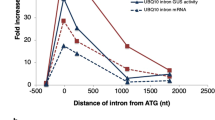Abstract
In this study, an Ac-based gene trap construct was engineered to increase gene trapping efficiency by an effective use of triple acceptor sites preceding a reporter gene. The target of the engineering process was a synthetic intron preceding the GUS reporter. Two different gene trap constructs were designed. In one construct, three of the sequence elements serving as signals for recognition of an intron 3′ boundary were systematically modified to allow for almost optimal acceptor site recognition, while these sequences remained unchanged in the other construct. To compare recognition of the engineered intron with that of the unmodified intron, tester constructs were transiently transformed into barley (Hordeum vulgare L.) tissue and the accuracy and efficiency of splicing was determined by mRNA mapping and reporter-gene expression frequency analysis. By employing this test system, we could show that systematic engineering of the intron sequence elements results in advanced intron recognition, compared to the unmodified intron, and that all three acceptor sites were activated, but with unequal frequency. The impact of our findings on reporter expression in a gene-trap approach is discussed.



Similar content being viewed by others
Abbreviations
- Act1 :
-
Actin1
- GBSS1 :
-
Granule-bound starch synthase
- GUS :
-
β-Glucuronidase
- RT–PCR :
-
Reverse transcription–polymerase chain reaction
- SOE :
-
Splicing by overlap extension
- Ubi1 :
-
Ubiquitin1
References
Brendel V, Kleffe J (1998) Prediction of locally optimal splice sites in plant pre-mRNA with applications to gene identification in Arabidopsis thaliana genomic DNA. Nucleic Acids Res 26:4748–4757
Brown JWS, Simpson CG (1998) Splice site selection in plant pre-mRNA splicing. Annu Rev Plant Physiol Plant Mol Biol 49:77–95
Brown JW, Simpson CG, Thow G, Clark GP, Jennings SN, Medina-Escobar N, Haupt S, Chapman SC, Oparka KJ (2002) Splicing signals and factors in plant intron removal. Biochem Soc Trans 30:146–149
Christensen AH, Sharrock RA, Quail PH (1992) Maize polyubiquitin genes: structure, thermal perturbation of expression and transcript splicing, and promoter activity following transfer to protoplasts by electroporation. Plant Mol Biol 18:675–689
Cone KC, Burr FA, Burr B (1986) Molecular analysis of the maize anthocyanin regulatory locus C1. Proc Natl Acad Sci USA 83:9631–9635
Horton RM, Hunt HD, Ho SN, Pullen JK, Pease LR (1989) Engineering hybrid genes without the use of restriction enzymes: gene splicing by overlap extension. Gene 77:61–68
Jefferson RA, Kavanagh TA, Bevan MW (1987) GUS fusions: beta-glucuronidase as a sensitive and versatile gene fusion marker in higher plants. EMBO J 6:3901–3907
Lorkovic ZJ, Wieczorek-Kirk DA, Lambermon MH, Filipowicz W (2000) Pre-mRNA splicing in higher plants. Trends Plant Sci 5:160–167
Ludwig SR, Habera LF, Dellaporta SL, Wessler SR (1989) Lc, a member of the maize R gene family responsible for tissue-specific anthocyanin production, encodes a protein similar to transcriptional activators and contains the myc-homology region. Proc Natl Acad Sci USA 86:7092–8006
McCullough AJ, Baynton CE, Schuler MA (1996) Interactions across exons can influence splice site recognition in plant nuclei. Plant Cell 8:2295–2307
McElroy D, Zhang W, Cao J, Wu R (1990) Isolation of an efficient actin promotor for use in rice transformation. Plant Cell 2:163–171
McElroy D, Blowers AD, Jenes B, Wu R (1991) Construction of expression vectors based on the rice actin 1 (Act1) 5′ region for use in monocot transformation. Mol Gen Genet 231:150–160
Scholz S, Lörz H, Lütticke S (2001) Transposition of the maize transposable element Ac in barley (Hordeum vulgare L.). Mol Gen Genet 264:653–661
Sheikh SN, Lazarus, P (1997) Re-usable DNA template for the polymerase chain reaction. Nucleic Acids Res 25:3537–3542
Simpson GG, Filipowicz W (1996) Splicing of precursors to mRNA in higher plants: mechanism, regulation and sub-nuclear organisation of the spliceosomal machinery. Plant Mol Biol 32:1–41
Simpson C, McQuade C, Lyon J, Brown JW (1998) Characterization of exon skipping mutants of the COP1 gene from Arabidopsis. Plant J 15:125–131
Simpson CG, Hedley PE, Watters JA, Clark GP, McQuade C, Machray GC, Brown JW (2000) Requirements for mini-exon inclusion in potato invertase mRNAs provides evidence for exon-scanning interactions in plants. RNA 6:422–433
Simpson CG, Thow G, Clark G, Jennings SN, Watters J, Brown JWS (2002) Mutational analysis of a plant branchpoint and polypyrimidine tract required for constitutive splicing of a mini-exon. RNA 8:47–56
Smith CW, Chu TT, Nadal-Ginard B (1993) Scanning and competition between AGs are involved in 3′ splice site selection in mammalian introns. Mol Cell Biol 13:4939–4952
Springer PS (2000) Gene traps. Tools for plant development and genomics. Plant Cell 12:1007–1020
Acknowledgements
The authors thank Sabina Miaskowska for technical support and Stefan Scholten, Margarete Hunt and Horst Lörz (Center for Applied Plant Molecular Biology, University of Hamburg, Hamburg, Germany) for critical comment upon the manuscript. We also thank the Deutsche Forschungsgemeinschaft (LU/518/3-3) for partly supporting this work. The experimental data presented here also appeared in the doctoral thesis of C.B.
Author information
Authors and Affiliations
Corresponding author
Rights and permissions
About this article
Cite this article
Bergmann, C., Lütticke, S. Analysis of splice donor and acceptor function in a novel Ac-based gene trap construct. Planta 219, 876–883 (2004). https://doi.org/10.1007/s00425-004-1286-6
Received:
Accepted:
Published:
Issue Date:
DOI: https://doi.org/10.1007/s00425-004-1286-6




